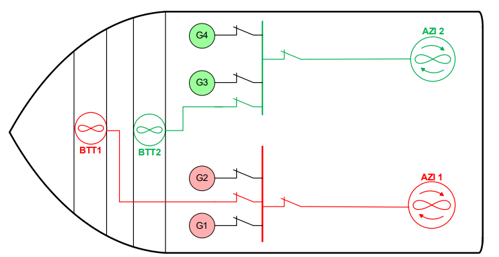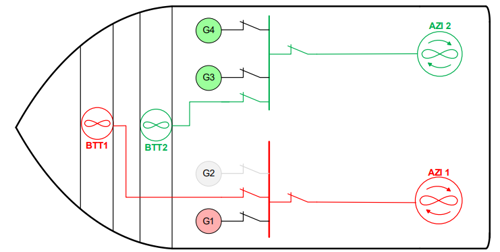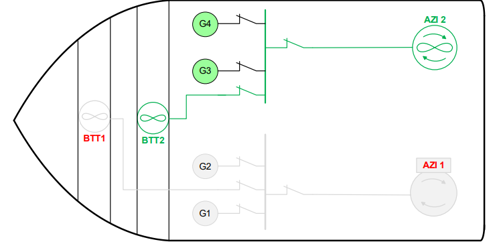Follow the ASOG – It’s there for a reason
- DP Event
- Published on 22 December 2023
- Generated on 22 December 2025
- DPE 04/23
- 4 minute read
Incident
Jump to:
A DP vessel was conducting ROV operations beside an oil platform. One of the generators connected to the port switchboard failed and tripped.
Overview
A DP vessel was conducting remotely operated vehicle (ROV) operations beside an oil platform. As this was a Critical Activity Mode (CAM), the vessel was operating a split bus with two generators connected to each switchboard.
One of the generators connected to the port switchboard failed and tripped, there was no effect on vessel station keeping and the remaining connected generator was able to accept the extra load transferred. However, the vessel was operating in a degraded mode and the risk of worst-case failure was greater.
Per the ASOG, the vessel moved to a yellow alert level, the ROV was called back to its Tether Management System (TMS) and the vessel started to move in a controlled manner away from the platform.
Shortly after, and before the vessel left the 500m zone, the port redundant group blacked out, this equalled the Worst Case Failure Design Intent (WCFDI).
Operational setup
Vessel configuration: The vessel was operating in a split bus configuration, a standard practice in DP operations to enhance electrical redundancy and reliability. This set-up involved two generators connected to separate switchboards (port and starboard).

Figure: Power Configuration Prior to Event

Figure: Power Configuration Following Initial Failure of G2
The primary operation involved ROV deployment for subsea tasks adjacent to the oil platform, classified as a Critical Activity Mode (CAM) due to the proximity to the platform and the nature of the operations.
Incident overview
Initial Generator Failure: During operations, one of the generators connected to the port switchboard experienced a failure and subsequent trip. This incident posed a potential risk to the vessel’s DP capability and, by extension, to the ROV operations and the nearby oil platform.
Immediate Response and System Resilience: The vessel’s DP system demonstrated resilience through redundancy. The remaining generator on the port switchboard successfully accepted the additional load, ensuring no immediate impact on the vessel’s station-keeping ability.
Procedural Response: Shift to Yellow Level: In accordance with the Activity Specific Operating Guidelines (ASOG), the vessel’s operational status was changed to a ‘yellow level’. This change in status indicated a heightened awareness and a move towards conservative operational measures.
ROV Recall: As a precaution, the ROV was ordered to return to its TMS, signalling a temporary halt to subsea operations.
Vessel Repositioning: The vessel commenced manoeuvres to move away from the oil platform, reducing the risk of any potential impact due to the compromised redundancy in its power generation and distribution system.
Secondary Incident: Port Redundant Group Blackout: In a subsequent development, the port redundant group experienced a complete blackout. This incident occurred before the vessel exited the 500m safety zone around the platform.
Worst Case Failure Design Intent (WCFDI): The partial blackout represented a scenario equivalent to the WCFDI, a critical threshold in DP operations. This scenario envisages the most severe failure the DP system is designed to withstand while maintaining position.
What happened?
After the generator failed, the vessel technical staff initiated the fault-finding process and, or so they believed, discovered the issue without delay. They attempted to reconnect the generator after incorrectly concluding that they had identified the problem – however, doing so resulted in a voltage spike on the main switchboard, which subsequently caused a complete blackout of that switchboard.

Figure: Power configuration after attempting to re-connect G2
Conclusion
This incident underscores the importance of robust DP system design and the efficacy of procedural responses in managing unexpected failures. Key takeaways include:
- The impact of attaining a Yellow alert status in the ASOG was defeated when the technical staff of the vessel bypassed the ASOG and re-established the generator connection. It was unequivocally stated by the ASOG that machinery should not be reinstated until the vessel was in a safe position or status, which effectively meant being outside the 500m zone.
- System resilience: The ability of the remaining generator to assume additional load highlights the importance of designing DP systems with adequate redundancy and load-sharing capabilities, and, operating the DP system within its designed capability.
- Need for continuous monitoring: Continuous monitoring and regular maintenance of all critical systems, especially power generation and distribution in DP vessels, are essential to prevent such incidents.
- Training and preparedness: Regular training and drills for vessel crews on managing such emergencies are crucial for ensuring safety during critical operations like ROV deployment near oil platforms.
- Effective emergency protocols – ASOG: The swift transition to a yellow alert level and the immediate recall of the ROV demonstrate the vessel crew’s adherence to ASOG and their preparedness to respond to emergencies.
Latest DP incidents
-
Simultaneous Operations
A DP Incident report highlighting the importance of maintaining focus during time on the DP desk
DPE 03/25
18 December 2025
Incident
-
DP drill scenario
DP emergency drill scenarios are included to assist DP vessel management and DPOs / Engineers and ETOs to conduct DP drills onboard.
DPE 03/25
18 December 2025
Drill Scenario
-
Know your settings
This Dynamic Positioning (DP) incident involved a DP equipment class 2 offshore supply vessel (OSV) during loadout operations from a drilling rig.
DPE 03/25
18 December 2025
Incident
-
Importance of familiarisation and paying attention
The importance of maintaining full attention during the operator's time on the DP desk can never be underestimated, or forgotten
DPE 03/25
18 December 2025
Incident
-
Worst case failure preparedness
Operators must be prepared for worst case failures
DPE 03/25
18 December 2025
Incident
The case studies and observations above have been compiled from information received by IMCA. All vessel, client, and operational data has been removed from the narrative to ensure anonymity. Case studies are not intended as guidance on the safe conduct of operations, but rather to assist vessel managers, DP operators, and technical crew.
IMCA makes every effort to ensure both the accuracy and reliability of the information, but it is not liable for any guidance and/or recommendation and/or statement herein contained.
Any queries should be directed to DP team at IMCA. Share your DP incidents with IMCA online. Sign-up to receive DP event bulletins straight to your email.